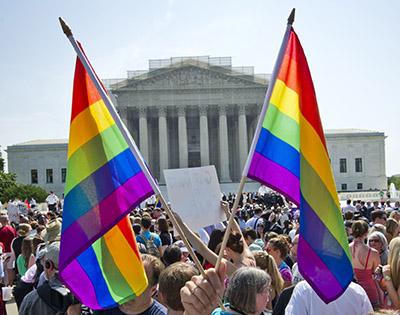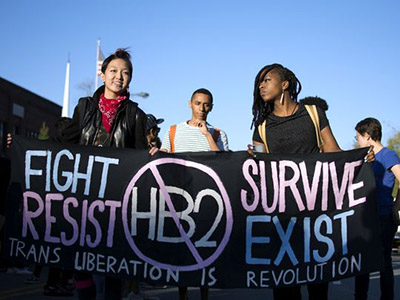by Donna Cartwright
August 19, 2016
A year after marriage equality was legalized nationwide, and two months since the June 12 massacre at a gay club in Orlando, the LGBT movement confronts a contradictory future. Although Orlando dramatized that violence against LGBT people persists, fueled by rightwing politicians’ hateful attacks, great victories have been won, and public acceptance of queer people has expanded to levels that once seemed unimaginable.

Millions celebrated the Supreme Court’s decision on marriage equality.
But some of these victories have been constrained by the social structures of neoliberal capitalism, and by a misleading yet widespread public perception that with the achievement of marriage equality, the fight for queer liberation is largely over. The LGBT movement has also undergone problematic changes, having become increasingly professionalized and money driven in the last 15 years or so. Major donors and large foundations call the shots. Many young activists have been drawn into a top-down, NGO-based model of organization.
Marriage Problems
While marriage equality was a great victory for LGBT people, it comes with some problematic consequences. The substantial material benefits of marriage are now available to those in the LGBT community who choose that path, but they’ve come only on capitalism’s terms. This has meant giving up on the more radical vision of the movement’s earlier years–one that sought “recognition of diverse kinds of partnerships, households, kinship relationships and families,” in the words of “Beyond Same-Sex Marriage,” a 2006 statement signed by dozens of intellectual leaders and activists in the movement.
That statement called for “access to a flexible set of economic benefits and options regardless of sexual orientation, race, gender/gender identity, class, or citizenship status.” Instead, gay couples who choose to marry are, like straight people, enmeshed in the restrictions imposed by capitalist social reproduction: the nuclear family, difficulties in access to child care and family leave, and inadequate systems of health insurance and retirement security.
For example, for most adults who are in school or working, access to health insurance is available, or not, based on who your employer is, who your spouse is, or who your parents are. All of these are dependency relationships. Universal access to benefits remains out of reach. Domestic partner benefits, developed to give same-sex couples who could not marry access to health insurance, were sometimes extended to straight people as well, offering a glimpse of a less rigidly structured framework of social relationships.
But in the last few years, some states, like Maryland and Arizona, that offered domestic partner benefits only to same-sex couples have eliminated them. Washington converted all domestic-partners under 62 to married couples automatically. And private employers seem more likely to drop these benefits than public ones. A survey by the Society for Human Resources Management (cited in a Pew Charitable Trusts publication) indicated that almost half of employers that offered d.p. benefits to same-sex couples only are planning to drop them, while more than a third of companies that offered domestic partner benefits to straight and gay couples said they might curtail them.
Loosening Social Solidarity
Another problematic aspect of the over-emphasis on marriage equality in the queer movement has been the shift in focus toward the relationship of individuals with the state, obscuring the role of private employers in maintaining conventional social norms, and de-emphasizing the need for broader social solidarity.
As sexual and gender diversity are becoming the new normal, the ties of solidarity that sustained a marginalized and persecuted community grow looser. Assimilation appears to be weakening the social cohesion of the LGBT community and starving its once-dense network of institutions and resources. Now, with money drying up, many of the smaller organizations and some large ones are shrinking, merging, or closing down.
For example, Empire State Pride Agenda (ESPA), New York State’s leading LGBT policy advocacy group for the last 25 years, abruptly closed its doors last December, claiming that it had accomplished its major policy goals. ESPA, which had long been one of the largest and wealthiest LGBT organizations, apparently was facing fundraising difficulties. Queer activists and even some politicians expressed outrage, pointing out that transgender people still lack statewide anti-discrimination protection in New York, and that much needs to be done to support queer youth and gain legal status for alternative family structures (see Slate, Dec. 16 2015).
Tellingly, the mainstream LGBT movement’s efforts to project a public image of queer people to the general public have been influenced in the same “normalizing” direction. The rebellious street-fighters of the Stonewall Rebellion, the sexual radicals of the 1980s, and the angry Act-Up protesters have been mellowed into monogamous, well-educated, middle- to upper-middle class professional couples blending effortlessly into suburban landscapes complete with white picket fences. Racial and ethnic diversity is often played down, and working class queers are largely invisible in this homogenous public-relations dream. The emergence of “non-binary” identities among queer youth (those who reject either traditional male or female identities) has also been neglected.
All of the preceding has serious implications for the part of the LGBT community that is not white, male, and well-educated or well-connected. Discrimination and social exclusion remain major issues, particularly for queer people of color, youth, and trans people. About a quarter to a third of gay, lesbian, and bi people report experiencing discrimination; for trans people the proportions are two-thirds to three-quarters.
New Attacks, New Struggles

Meanwhile, the right-wing opposition has regrouped and is seeking to exploit public fears of transgender people. Scores of anti-LGBT bills have been introduced in state legislatures, culminating in North Carolina’s notorious HB 2, which forbids municipalities to enact anti-discrimination laws, and prohibits transgender people from using restrooms in public buildings that correspond to their gender identity.
National anti-discrimination legislation is still badly needed. In large parts of the country, same sex couples can marry on Sunday and get fired on Monday if word gets out. But anti-discrimination legislation has its own limitations–as with marriage, it provides protection only within the framework of capitalist social relations, so employers and businesses have a built-in advantage against individual claims of discrimination, and the time and expense of the process renders it only marginally available to many people.
The mainstream LGBT movement, weakened by complacency and narrowness of vision, seems ill-prepared to deal with these challenges. Fortunately, there are some organizations like Southerners on New Ground (SONG) and BreakOut!, to name just two, led largely by young queer and trans people of color, that are doing good work and can help show us a better path to resistance. We can only hope that revitalized, mass-based struggles will emerge to develop these struggles.
Donna Cartwright is a member of Solidarity in Baltimore, and a longtime activist in the labor movement and in Pride at Work.

Comments
One response to “The LGBTQ Movement Today”